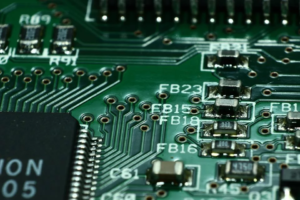UV laser application in various PCB materials
Ultraviolet lasers are the best choice for a variety of PCB materials in many industrial applications, from the most basic circuit boards, circuit wiring, to advanced processes such as pocket-sized embedded chips. The variability of this material makes UV lasers the best choice for a wide range of PCB materials in many industrial applications, from the most basic boards, circuit wiring, to advanced processes such as pocket-sized embedded chips.
Application 1: Surface Etching / Circuit Production
Ultraviolet lasers work quickly in the production of circuits, and surface patterns can be etched onto the board in minutes. This makes UV lasers the fastest way to produce PCB samples. The R&D department noted that more and more sample laboratories are being equipped with internal UV laser systems.
Depending on the optical instrument verification, the UV laser beam can be 10-20 μm in size, producing flexible circuit traces. The application in Figure 2 shows the greatest advantage of UV in the production of circuit traces, which are extremely small and need to be visible under a microscope.
The board measures 0.75″ x 0.5″ and consists of a sintered ceramic substrate and a tungsten/nickel/copper/surface. The laser is capable of producing 2 mils of circuit traces at a distance of 1 mil, resulting in a total pitch of only 3 mils.
Although the use of laser beam production circuits is the fastest method of PCB samples, large-scale surface etching applications are best left to the chemical process.
Application 2: PCB removal
Ultraviolet laser cutting is an excellent choice for large or small production, and it is also a good choice for PCB disassembly, especially when it is needed on flexible or rigid-flex boards. Disassembly is the removal of a single board from the panel. Considering the increasing flexibility of the material, this disassembly poses a major challenge.
Mechanical disassembly methods such as V-groove cutting and automatic board cutting tend to damage sensitive and slim substrates, causing trouble for electronic professional manufacturing service (EMS) companies to disassemble flexible and rigid-flex circuit boards.
Ultraviolet laser cutting not only eliminates the effects of mechanical stresses during detachment processes such as edging, deformation, and damage to circuit components, but also has less thermal stress effects than other lasers such as CO2 laser cutting.
The reduction in “cutting cushions” saves space, which means that components can be placed closer to the edge of the line, and more lines can be installed on each board to maximize efficiency for maximum flexibility in flexible line applications. .
Application 3: Drilling
Another application that utilizes the small beam size and low stress properties of UV lasers is drilling, including through holes, microvias, and blind vias. The UV laser system drills through a focused vertical beam that cuts through the substrate. Depending on the material used, holes as small as 10 μm can be drilled.
Ultraviolet lasers are especially useful for multi-layer drilling. Multilayer PCBs are thermoformed together using composite materials. These so-called “semi-cured” separations occur, especially after processing with higher temperature lasers. However, the relatively stress-free properties of UV lasers solve this problem, as shown in Figure 4.
A 4 mil diameter hole was drilled into a 14 mil multi-layer panel on the cross-section shown. This application on a flexible polyimide copper plated substrate shows no separation between the layers. With regard to the low stress properties of UV lasers, it is also important to improve the yield data. Yield is the percentage of available boards that are removed from a panel.
In the manufacturing process, many conditions can cause damage to the board, including broken solder joints, broken components or delamination. Either factor can cause the board to be thrown into the waste bin on the production line rather than entering the shipping box.
Application 4: Deep engraving
Another application that demonstrates the versatility of UV lasers is deep engraving, which takes many forms. Using software control of the laser system, the laser beam is set to perform controlled ablation, ie to be able to cut on a material at the required depth, to stop, continue and complete before switching to another depth and starting another task Processing.
Various depth applications include small-scale production for embedding chips and surface grinding to remove organic materials from metal surfaces.
Ultraviolet lasers can also perform multi-step operations on the substrate. On polyethylene, the first step is to use a laser to create a groove with a depth of 2 mils, the second step is to create an 8 mils groove on the basis of the previous step, and the third step is a 10 mil groove. This illustrates the overall user control functionality provided by the UV laser system.
Conclusion: A versatile approach
The most striking thing about UV lasers is the ability to do all of these applications in a single step. What does this mean for manufacturing a circuit board? There is no longer a need to use an influential process and method to accomplish an application on different equipment, and a complete part can be obtained in a single process.
This streamlined production solution helps eliminate quality control issues that arise when boards are switched between processes. Ultraviolet-free debris-free ablation also means no post-processing cleaning is required.
Grace Zheng
Email: sales06@andwinpcb.com

